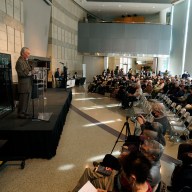Railroads like the LIRR, NJ Transit and Metro North, which bring more than 800,000 weekday commuters into New York City combined, are resuming most of their service in the wake of Hurricane Irene.
The MTA’s Metro-North Railroad resumed full weekday rail service on its Hudson line and the main branch of its New Haven line. The New Canaan branch and Metro-North’s main Harlem line are both up and running. Those lines carry more than 90 percent of Metro-North’s peak morning riders, according to Marjorie Anders, a Metro-North spokeswoman.
However, service on the Port Jervis line is suspended indefinitely after track beds were washed out by flooding, she said.
“Metro-North had some major challenges,” said Bill Henderson, executive director of the Permanent Citizens Advisory Committee to the MTA. “They had mudslides, they had flooding, I think they were waiting for the locusts next.”
The MTA cleared a mudslide 10 feet deep that covered two tracks at Metro-North’s Spuyten Duyvil station in the Bronx, Anders said.
MTA gets good marks
Henderson gave the transit agency good marks in dealing with the storm. “They had some big issues to deal with and they dealt with them,” he said. “It’s a combination of good strategy, work and luck. They were very close in Lower Manhattan to having some flooded tunnels and some real damage from the salt water.”
NJ Transit moving along
Most NJ Transit commuter rail lines — including the Morris and Essex, Main-Bergen County, Pascack Valley, Montclair-Boonton and North Jersey Coast — resumed regular service yesterday. However, the heavily-used Northeast Corridor line is still limited to running only between New Brunswick and New York City because of flooded tracks at the Trenton Transit Center.
“Fifty percent of the trains that are used on the Northeast Corridor are on the other side of the Trenton Transit Center” in a storage yard in Morrisville, Pennsylvania, said NJ Transit spokeswoman Penny Bassett Hackett. “We just don’t have the equipment.”
The cars were stashed there to prevent hurricane damage, and engineers have no estimates for when they could be returned to New Jersey, she said. Systemwide, NJ Transit crews removed 400 trees that had fallen on the tracks.
















